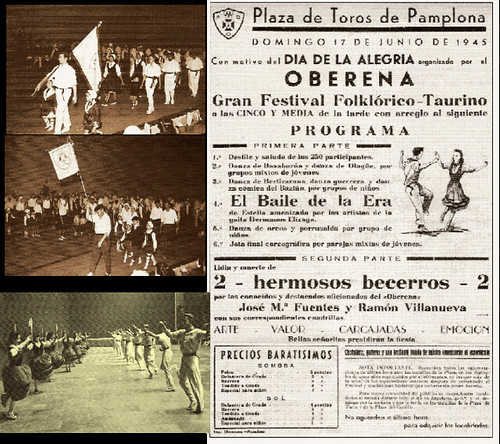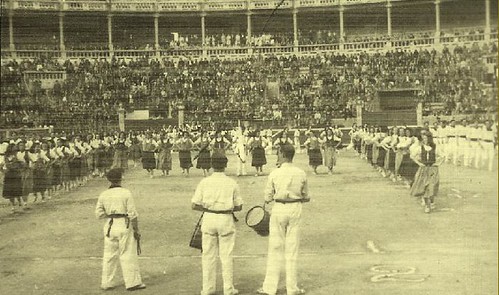History
The January 20, 1941 Oberena founders decided to give more importance to the folklore and the peña. The dance group emerged in the wake of the letter of Pentecostes, which disapproved gripped dancing and, at the same time, invited young people to endorse the places where the dance was lost. In the beginning, the group was exclusively formed by men, who danced for the first time in Monreal, on August 15th. In Pamplona, they premiered on a December 3rd in Perkain pelota court. This date became very important for the group, and that’s why Oberena’s dancer day is celebrated then every year. At the end of the year the group noticed the lack of something essential: women. Therefore, women started to be part of the dance group too. In those years full of illusion, they recovered dances such as Zozo dantza, Ezpatadantza, Eskudantza and Larraindantza (La Era), while they rehearsed in the “zulos” of Zapatería 40. Normally, they used to dance on Sundays, sometimes on festivities and some other times taking advantage of the soccer team’s trips. The group offered shows in lots of villages of Navarre, and in Pamplona they used to dance in places such as the Euskal Jai pelota court (demolished in 2004), the Meca, the Gayarre Theatre and Perkain pelota court.

Oberena consisted of more than 100 couples who used to fill the bull stadium of Pamplona in the “Alaitasun Eguna”. In 1946 the group crossed our frontiers for the first time to go to Zaragoza; in the ‘50s they danced at the fair of Madrid and thereafter began traveling.
During Christmas of 1960, Oberena Dantza Taldea prepared a festival in Labrit, which was repeated until 1974. With the help of Orfeón Pamplonés and the military band (later relieved by Orquesta Santa Cecilia) they used to perform Eusko Irudiak, the prelude of El Caserío and Jesús Guridi’s Ezpatadantza de Amaya.

In 1965 the “Misterio de Obanos” was premiered in the village’s square. 18 couples of Oberena danced Miguel Reta’s choreographies on the play that nowadays is still performed.
Overcoming all obstacles, in the ‘70s Oberena Dantza Taldea was headed to Ireland. That trip also marked the beginning of a series of ruptures and divisions that led the group to two decades of internal conflicts and disagreements. The first rupture, in 1973, ended with the departure of a big part of the dancers, who subsequently founded Ortzadar Euskal Folklore Elkartea. Later on, in the beginning of the ‘80s, new internal disagreements ended with another departure of an important number of dancers, many of which would become part of the newly created dance group of Burlada Larratz.
Concurrently to these internal issues, the group continued learning dances, expanding repertoires, offering shows and performances, travelling (Mallorca, France…), recovering costumes and wardrobe, and specially, working on a source of young dancers who, eventually, would take the reins of the group. That labour and those people were the ones that enabled to maintain the group and recover its stability at the end of the ‘80s.
With the ‘90s arose the group’s 50th anniversary. Specifically, it was 1991 when the Labrit pelota court held a festival with hundreds of dancers and ex-dancers. This decade came along with trips and prestigious international festivals in countries such as Bulgaria, Canada, Germany, Austria and Switzerland, or cities of Spain such as Gijón, Murcia, Sevilla, Ciudad Real… Apart from that, the group kept on acting in many village of our Basque geography, while it also learned and incorporated new dances to its repertoire.
The entry in the 21st century has been a continuation of those ‘90s: an excellent work with children that is taking off today with more than 100 young dancers learning and enjoying Basque folklore, a wide and varied repertoire to which every year a new dance is added, an endless number of shows in our villages: Otsagabia, Leitza, Tiebas, Cintruénigo, Cortes… There have also been trips, and the dancers have visited France, Italy, Germany, Albania, Hungary, Poland and different cities of the Spanish state such as Gijón, Lleida, A Coruña, Huesca, Granada… But above all, a desire and a huge enthusiasm to continue recovering, maintaining and disseminating our rich Basque folklore. For many years.
Overcoming all obstacles, in the ‘70s Oberena Dantza Taldea was headed to Ireland. That trip also marked the beginning of a series of ruptures and divisions that led the group to two decades of internal conflicts and disagreements. The first rupture, in 1973, ended with the departure of a big part of the dancers, who subsequently founded Ortzadar Euskal Folklore Elkartea. Later on, in the beginning of the ‘80s, new internal disagreements ended with another departure of an important number of dancers, many of which would become part of the newly created dance group of Burlada Larratz.
Concurrently to these internal issues, the group continued learning dances, expanding repertoires, offering shows and performances, travelling (Mallorca, France…), recovering costumes and wardrobe, and specially, working on a source of young dancers who, eventually, would take the reins of the group. That labour and those people were the ones that enabled to maintain the group and recover its stability at the end of the ‘80s.
With the ‘90s arose the group’s 50th anniversary. Specifically, it was 1991 when the Labrit pelota court held a festival with hundreds of dancers and ex-dancers. This decade came along with trips and prestigious international festivals in countries such as Bulgaria, Canada, Germany, Austria and Switzerland, or cities of Spain such as Gijón, Murcia, Sevilla, Ciudad Real… Apart from that, the group kept on acting in many village of our Basque geography, while it also learned and incorporated new dances to its repertoire.
The entry in the 21st century has been a continuation of those ‘90s: an excellent work with children that is taking off today with more than 100 young dancers learning and enjoying Basque folklore, a wide and varied repertoire to which every year a new dance is added, an endless number of shows in our villages: Otsagabia, Leitza, Tiebas, Cintruénigo, Cortes… There have also been trips, and the dancers have visited France, Italy, Germany, Albania, Hungary, Poland and different cities of the Spanish state such as Gijón, Lleida, A Coruña, Huesca, Granada… But above all, a desire and a huge enthusiasm to continue recovering, maintaining and disseminating our rich Basque folklore. For many years.
